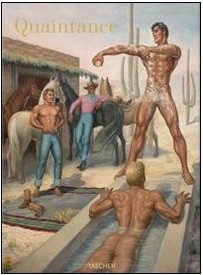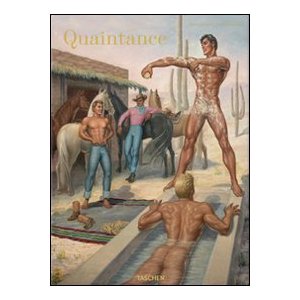 The Flamboyant Life and Forbidden Art of George Quaintance
The Flamboyant Life and Forbidden Art of George Quaintance
by Reed Massengill
Edited by Dian Hanson
Taschen. 156 pages, $99.99
FEW ARTISTS, even those of great fame or historical importance, receive such magnificent treatment in a published monograph as George Quaintance (1902-1957), painter of beefcake images from the 1940’s and 50’s, receives in this volume. Known mostly to bodybuilders and physical culture fans of those decades and to legions of gay men of the pre-Stonewall years who were starving for images of hot men, Quaintance’s paintings graced the covers of many now-classic physique magazines. Today, his images tend to be regarded as icons of high kitsch.
Measuring nearly sixteen by twelve inches, The Flamboyant Life and Forbidden Art of George Quaintance contains eight double-page spreads, four triple-page foldouts, 46 pages of documentary photographs and illustrations with a readily accessible biographical essay by Reed Massengill in English, German, and French, a 76-page chapter of selected works, and a thirty-page final chapter illustrating and documenting (with commentaries by Ken Furtado) the artist’s complete 55-painting œuvre. There’s even a built-in satin ribbon bookmark. This is an exceptionally elegant volume.
As an artist, Quaintance was bound by his repressive times, which dictated how much he could reveal of the young men he idealized. Showing the penis was verboten, as was sending such undraped images of men through the U.S. postal system. Quaintance generally painted his men with genitals exposed, then before they left his studio he would artfully paint in drapes, snakes, soapsuds, a boot, or another object to cover the offending anatomical details. The book does offer a few examples of some paintings in their earlier “unfinished” states.
Technically, Quaintance was a rather traditional, if consistently stylized, figure painter rather than an experimental or artistically risky modernist. The reproductions show a talented amateur with some training who cared more about the final image than the physical process of creating it. Like his more famous successor, Tom of Finland, he was motivated by the sensuality and implied sexuality of his hunky male subjects, with whom he is implicitly making love in these paintings.
Like the artist, the subjects in these paintings are locked in their era. Nearly all the men are depicted with slicked-back military-style haircuts, manicured and polished fingernails, and cleanly shaved faces. There is also a gentle application of shaded color on their eyelids, idealized though not exaggerated musculature, oiled bodies, and in general the look of men who could easily be pictured riding a motorcycle.
Many are clad in leather boots and bulge-revealing jeans—Quaintance was perhaps the first artist to fetishize blue jeans as a hot look for gay men—accompanied by settings and props that have also become iconically gay (the wild West, bathhouses, secluded beaches, etc.). And the types of masculinity he chose to depict would become gay standards, as well: cowboys and ranch hands, matadors, Greek and Roman gods, athletes, slaves, and soldiers, along with swimmers, native American, sailors, and blue collar workers. Enter the Village people—twenty years later.
To be sure, George Quaintance deserves his status as an important contributor to gay contemporary visual culture and history. Massengill, Hanson, Furtado, and Taschen have succeeded boldly with this beautiful tribute of a book.
________________________________________________________
David B. Boyce is a freelance curator and arts writer living in New Bedford, MA.






